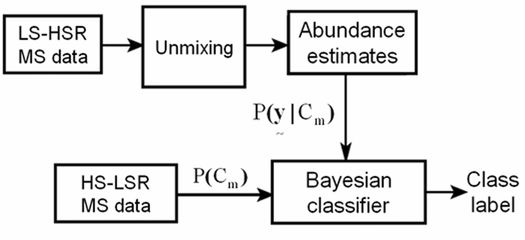Uttam Kumar | S. Kumar Raja | C. Mukhopadhyay | T. V. Ramachandra* |
| Citation: Uttam Kumar, S. Kumar Raja, C. Mukhopadhyay and T. V. Ramachandra , 2011, Hybrid Bayesian Classifier for Improved Classification Accuracy. IEEE Geoscience and Remote Sensing letters, Vol. 8, No. 3, pp. 473 – 476. | |||
|
INTRODUCTION IMAGE classification using conventional Bayesian classifier is a supervised method based on the prior probabilities [1]. Prior probability resolves confusions among classes that are not well separable [2] and is therefore effective in improving classification accuracy. Bayesian classifier is generally used with the assumption that prior probabilities are equal, as reliable prior probabilities are not easily available. However, with the use of equal prior probabilities, the performance of the classifier is not optimal [3] which is evident from the misclassified pixels primarily due to spectral confusion between classes, apart from the increased computing and sampling requirements [4]. The theoretical analysis of the effect of prior probability has been discussed in detail by Z. Mingguo et al., (2009) [5]. Earlier works used prior probabilities based on previous year crop statistics [6], geographical data [7], elevation data [8] and spatial characteristics specified through a Markov random field model at reference resolution [9], improving the overall accuracy and Kappa coefficient. Therefore, it is desirable to obtain reliable prior probabilities for each spectral class and use them to classify the pixels that are likely to misclassify [1], even though they are difficult to determine within the same time period and for the same spectral classes. In this context, a new classification method - Hybrid Bayesian classifier (HBC)based on linear unmixing and Bayesian classifier is proposed to assign a class label to each pixel in a high spatial-low spectral resolution (HS-LSR) multispectral (MS) data. The prior probabilities of the different classes in the Bayesian classifier to classify each pixel in the HS-LSR data such as IRS LISS-III MS and IKONOS MS are obtained from abundance estimates by unmixing low spatial-high spectral resolution (LS-HSR) MS data such as MODIS and Landsat ETM+ respectively. The terms HS-LSR and LS-HSR have been used in a relative sense here, depending upon the spatial resolution of the images. For example, in the first experiment, MODIS bands are referred as LS-HSR and IRS LISS-III MS bands are HS-LSR data, while in the second experiment, Landsat ETM+ bands are LS-HSR and IKONOS MS bands are HS-LSR data. The reason for selecting MODIS and Landsat ETM+ images as LS-HSR supplement data is because of their economic viability and high temporal resolution that enables their procurement for any part of the globe, throughout the year corresponding to any HS-LSR data. However, the technique in general, can be applied on any other LS-HSR (such as hyperspectral bands) and HS-LSR (such as multispectral bands) data classification. The novelty of this approach lies in the fact that low spatial-high spectral and low spectral-high spatial resolution MS data are combined to improve the classification results which can be thought of as a fusion process, in the sense, that information from two different sources (sensors) are combined to arrive at a improved classified image by systematically exploiting the relevant information from both the sources as shown in Fig. 1. Zhukov et al., (1999) [10] attempted a similar multisensor multiresolution image fusion based on low spatial resolution (LSR) unmixing and high spatial resolution (HSR) classification. However, the end product was not a classified image, but a set of MS fused images equivalent to the number of LSR bands at the HSR image dimension. In the following section, linear unmixing using Orthogonal Subspace Projection (OSP) and Bayesian classifier are reviewed. The proposed HBC is discussed in Section III while section IV demonstrates the experimental results and validation followed by conclusion in Section V.
|
*T. V. Ramachandra, Senior Member, IEEE, is with the Centre for Ecological Sciences, Centre for Sustainable Technologies and Centre for Infrastructure, Sustainable Transport and Urban Planning, Indian Institute of Science (IISc), Bangalore, India. Uttam Kumar, Student Member, IEEE, is with the Department of Management Studies and Centre for Sustainable Technologies, Indian Institute of Science, India. (e-mail: uttam@ces.iisc.ac.in). Chiranjit Mukhopadhyay is with the Department of Management Studies, Indian Institute of Science, Bangalore, India (e-mail: cm@mgmt.iisc.ac.in). S. Kumar Raja is with the VISTA Group, IRISA, Rennes, France and Thomson R&D France, SNC Cesson - Sévigné, France (email: s.kumar.raja@yahoo.com). |


